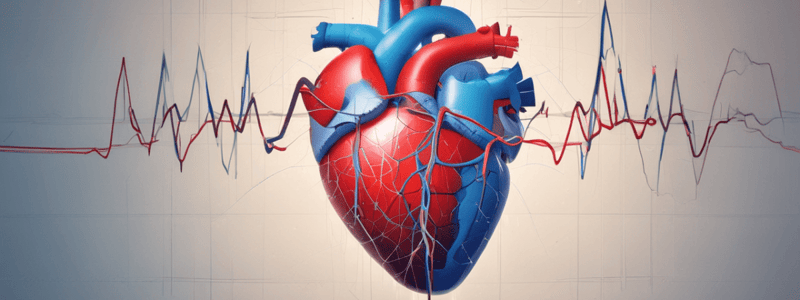Podcast
Questions and Answers
What is the typical duration of the T wave in a normal ECG?
What is the typical duration of the T wave in a normal ECG?
- 0.5-0.6 seconds
- 0.3-0.4 seconds (correct)
- 0.7-0.8 seconds
- 0.1-0.2 seconds
What does the ST segment represent in the ECG waveform?
What does the ST segment represent in the ECG waveform?
- Ventricular contraction (correct)
- Ventricular repolarization
- Atrial depolarization
- Electrical conduction through the AV node
What is the PR interval a measure of?
What is the PR interval a measure of?
- The duration of the QRS complex
- The time between the P wave and the QRS complex (correct)
- The duration of the P wave
- The time between the QRS complex and the T wave
What is the result of abnormal electrical activity in the ventricles during the T wave?
What is the result of abnormal electrical activity in the ventricles during the T wave?
What is the term for the shape of the ST segment when it is a straight line with no elevation or depression?
What is the term for the shape of the ST segment when it is a straight line with no elevation or depression?
What is the duration of the P wave in a normal electrocardiogram (ECG)?
What is the duration of the P wave in a normal electrocardiogram (ECG)?
What is the result of an abnormal ST segment elevation or depression?
What is the result of an abnormal ST segment elevation or depression?
What does the QRS complex represent in an ECG?
What does the QRS complex represent in an ECG?
What is the significance of a prolonged P wave duration in an ECG?
What is the significance of a prolonged P wave duration in an ECG?
What is the duration of the QRS complex in a normal ECG?
What is the duration of the QRS complex in a normal ECG?
What is the correct sequence of the ECG waveform?
What is the correct sequence of the ECG waveform?
What is the name of the segment that represents the period between the P wave and the QRS complex?
What is the name of the segment that represents the period between the P wave and the QRS complex?
Flashcards are hidden until you start studying
Study Notes
ECG Composition: Understanding the P Wave, QRS Complex, T Wave, and ST Segment
An electrocardiogram (ECG) is a non-invasive test that measures the electrical activity of the heart. It provides valuable information about the heart's rate and rhythm, as well as the overall health of the heart. The ECG composition consists of several distinct waveforms, including the P wave, QRS complex, T wave, and ST segment. Understanding these components helps healthcare professionals diagnose and monitor a variety of heart-related conditions.
P Wave
The P wave is the first portion of the ECG waveform, which represents the atrial depolarization phase. It is a positive wave that reflects the electrical activity of the atria, the upper chambers of the heart. The duration of the P wave is usually between 0.12 and 0.20 seconds in a normal ECG. A prolonged P wave duration may indicate an issue with the electrical conduction system of the heart, such as atrial fibrillation.
QRS Complex
The QRS complex is the second portion of the ECG waveform, which represents the ventricular depolarization phase. It is composed of the Q wave, R wave, and S wave, and is a positive and negative waveform that reflects the electrical activity of the ventricles, the lower chambers of the heart. The duration of the QRS complex is usually between 0.08 and 0.12 seconds in a normal ECG. A prolonged QRS complex duration may indicate a problem with the heart's electrical conduction system.
T Wave
The T wave is the third portion of the ECG waveform, which represents the ventricular repolarization phase. It is a negative waveform that reflects the electrical activity of the ventricles as they recover from depolarization. The duration of the T wave is usually between 0.3 and 0.4 seconds in a normal ECG. An abnormal T wave shape or duration may indicate a problem with the heart's electrical conduction system, such as a prolonged QT interval.
ST Segment
The ST segment is the portion of the ECG waveform that occurs after the QRS complex and before the T wave. It represents the period of time when the ventricles are contracting and pumping blood throughout the body. The ST segment is usually relatively flat and isocoric, meaning it should be a straight line with no significant elevation or depression in the ECG. An abnormal ST segment, such as an elevation or depression, may indicate a problem with blood flow to the heart muscle, such as a myocardial infarction or heart attack.
PR Interval
The PR interval is not a waveform on the ECG but rather the time between the beginning of the P wave and the beginning of the QRS complex. It reflects the time it takes for the electrical impulse to travel from the atria to the ventricles through the atrioventricular (AV) node. A prolonged PR interval may indicate a problem with the electrical conduction system of the heart, such as heart block.
In conclusion, understanding the ECG composition, including the P wave, QRS complex, T wave, ST segment, and PR interval, is crucial for healthcare professionals to diagnose and monitor a wide range of heart-related conditions. These ECG waveforms provide valuable information about the heart's electrical activity, rate, and rhythm, enabling healthcare providers to make informed decisions about treatment and patient care.
Studying That Suits You
Use AI to generate personalized quizzes and flashcards to suit your learning preferences.



